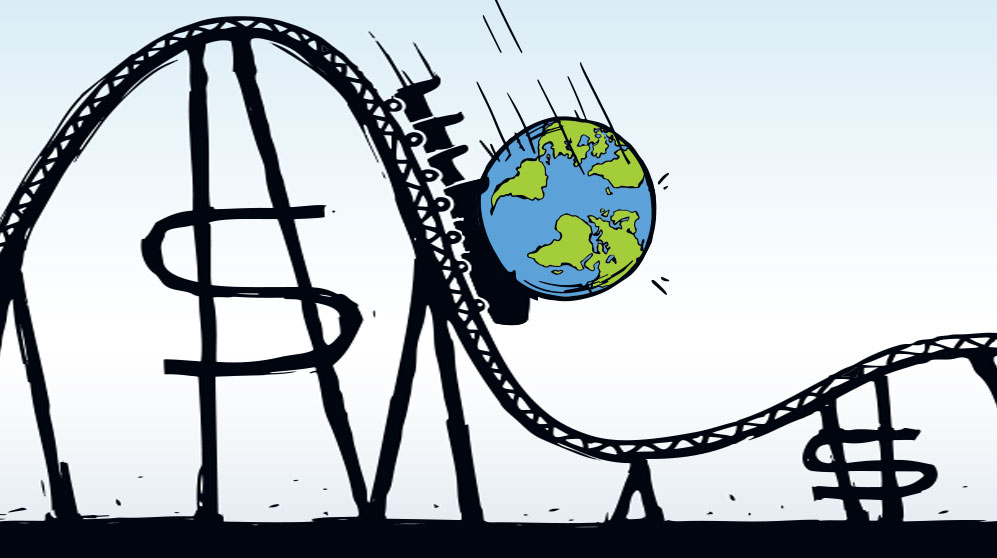Notes on the Economy – 1Q 2022 Summary
• 4 min read

Get the latest in Research & Insights
Sign up to receive a weekly email summary of new articles posted to AMG Research & Insights.

GLOBAL ECONOMY ON A ROLLER COASTER
The U.S. economy, along with the global economy, has been taking a ride on the COVID-19 roller coaster. The introduction of COVID-19 into the United States in early 2020 led to a drop in economic output of 31.2% in the second quarter. That was followed by a swift rebound. Real GDP growth was 6.7% in the second quarter of 2021 before the Delta variant precipitated a drop in growth to 2.3% in the third quarter, which was then followed by growth of 6.9% in the fourth quarter. It now appears, that following the arrival of the Omicron variant, first-quarter 2022 growth will be close to 2.0% but second quarter growth is likely to exceed 4.0%.
Although the magnitude and timing of such up-and-down growth episodes varies somewhat by country, the general pattern is observable on a global basis. In each case the introduction of a COVID-19 variant into the populace leads to concerns over personal safety and actions taken by governments that enforce various forms of social distancing. Such actions suppress consumption, inhibit the availability of labor, and disrupt supply chains, putting a damper on economic output.
The good news is that the hills and valleys of the COVID-19 roller coaster appear to be dampening with the introduction of each new variant. Increasing vaccination rates, the development of new vaccines and other effective treatments, and a spreading recognition by governments that social distancing protocols can have severe economic, physical, and mental costs are all contributing to the dampening.
HEADLINES – WHAT’S IMPORTANT
- COVID-19 Is Less Threatening but Not Gone – New caseloads due to the Omicron variant are falling off but, potentially, new variants could take over.
- Inflation Will Likely Peak in the First Half of 2022 – The Federal Reserve (Fed) will likely respond by tightening monetary policy, but inflation will remain above its 2.0% target well into 2023.
- High Inflation and Increasing Interest Rates Are Problematic for Financial Markets – They will squeeze profitability and reduce valuations. Relative safety and better return potential will rest among those financial instruments with higher-quality and lower-duration.
- Geopolitical Concerns Have Already Heightened Precious Metals – Precious metals can still play a role as portfolio insurance, but absent an intensified armed conflict, they are not attractive at current prices.
LOOKING AHEAD
Although far from certain, it is AMG’s working hypothesis that medical advances and practical experience will continue to dampen the roller coaster impact of new COVID-19 variants. It is apparent that the impact of the now-dominant Omicron variant is fading, as new case rates are falling swiftly. So, U.S. economic growth will likely pick up in 2022 after relatively weak growth in the first quarter, as the consequence of an outsized inventory buildup in the fourth quarter of 2021. Full year-over-year growth of real GDP should reach 4.1% in 2022, down from 5.7% in 2021, but still well above trend growth of potential real GDP.
High inflation will likely lead the Fed to reduce monetary accommodation starting in March. However, its initial actions during 2022 will likely still leave nominal interest rates low and real interest rates (i.e., net of inflation) negative. Currently, economic data signal that conditions conducive for growth predominate. Labor market conditions remain favorable for workers with unemployment at 4.0%, job openings exceeding the number of unemployed persons, and payrolls growing at well over 400,000 in each of the last nine months. The Institute for Supply Management’s Purchasing Managers Indices for both manufacturing and services remain in expansion territory, with new orders and backlogs notably elevated.
Global growth has started to slow from unsustainably high rates in 2021, and the Omicron variant might further impede a reacceleration. Still, the global PMIs compiled by IHS Market show that growth is continuing. The International Monetary Fund projects moderating, but still-strong, real GDP growth in 2022—4.4% for the world economy, 3.9% for the advanced economies, and 4.8% for emerging and developed economies. The projections are a bit optimistic, as they do not account for the impact of the Russian invasion of Ukraine.
* The information contained within this edition of the Notes on the Economy Executive Summary is based on data released as of February 25, 2022.
To receive a full copy of the Executive Summary or the entire 24-page “Notes on the Economy” report, contact your AMG advisor or submit a request for more information.
This information is for general information use only. It is not tailored to any specific situation, is not intended to be investment, tax, financial, legal, or other advice and should not be relied on as such. AMG’s opinions are subject to change without notice, and this report may not be updated to reflect changes in opinion. Forecasts, estimates, and certain other information contained herein are based on proprietary research and should not be considered investment advice or a recommendation to buy, sell or hold any particular security, strategy, or investment product.
Get the latest in Research & Insights
Sign up to receive a weekly email summary of new articles posted to AMG Research & Insights.




